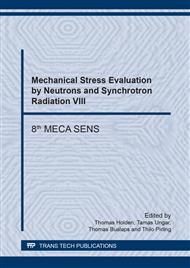p.131
p.137
p.143
p.151
p.157
p.165
p.174
p.182
p.190
Neutron Through-Thickness Stress Measurements in Coatings with High Spatial Resolution
Abstract:
A great variety of techniques are nowadays used to spray coatings with different functionality and properties for the purpose of surface enhancement. Depending on application and design, these can be thermal (plasma or high-velocity oxy-fuel are the most widely used) and warm or cold spraying, which are known to generate considerable residual stresses. This stress is a function of the spaying process as well as the material and thickness of the coating-substrate system. The mechanical integrity of coatings is critical for certain applications, e.g. wear resistant and thermal-barrier coatings, hence residual stress control and mitigation are essential in preventing the coating’s mechanical failure, improving the coating’s performance and the its operational lifetime. Although hole drilling technique or x-ray diffraction combined with layer removal method can be applicable for stress measurements in coatings, the neutron diffraction stress analysis also provides an effective and efficient tool for non-destructive through-thickness stress measurements with a commensurately high resolution, down to 0.1-0.2 mm. The most recent results of neutron diffraction stress measurements in coating systems are presented herein.
Info:
Periodical:
Pages:
165-173
Citation:
Online since:
August 2017
Authors:
Keywords:
Price:
Сopyright:
© 2017 Trans Tech Publications Ltd. All Rights Reserved
Share:
Citation:


